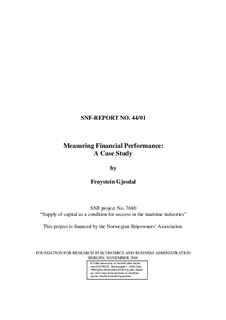| dc.contributor.author | Gjesdal, Frøystein | |
| dc.date.accessioned | 2006-07-04T12:00:40Z | |
| dc.date.available | 2006-07-04T12:00:40Z | |
| dc.date.issued | 2001-11 | |
| dc.identifier.isbn | 82-491-0167-7 (trykt versjon) | |
| dc.identifier.issn | 0803-4036 | |
| dc.identifier.uri | http://hdl.handle.net/11250/164729 | |
| dc.description.abstract | This paper studies long-term financial performance at the firm level. Fundamentally financial performance measurement is capital budgeting (or valuation) done ex post; expected cash flows and terminal values are replaced by realized or re-estimated flows and/or values. Beginning values may be derived from acquisition costs, opportunity costs or present (market) values at the start of the period. Similar choices must be faced with respect to terminal values. The interpretation of the performance measures differs accordingly. Note that there is no return concept corresponding to return on value in capital budgeting. For going concerns (accounting) book values represent acquisition costs. Hence choice of depreciation plan may affect the performance measure. Performance is measured relative to investors' required returns. Ex post some variations in required returns are known and must be incorporated in the analysis - in particular variations caused by changes in tax regimes as well as rates of inflation. In this paper it is assumed that investors have a fixed required real, risk-free rate of return after tax. Hence the nominal required return before tax depends on actual rates of inflation and taxes. Return on value for the case company - Odfjell ASA - is very close to estimated required return on equity over the 1986-97 period, about 16% before tax. However, estimated return on invested capital is smaller - in the 10% - 12% range depending on depreciation method. The empirical analysis also demonstrates that value added on capital employed and operational capital exceeds value added on equity. In an ex ante analysis this will not happen as long as financial markets are competitive. Further analysis indicates that foreign exchange gains and losses may explain this result. Whether movements in exchange rates have actually favoured holders of financial claims in the period or estimation errors are to blame, is unclear. | en |
| dc.format.extent | 283524 bytes | |
| dc.format.mimetype | application/pdf | |
| dc.language.iso | eng | en |
| dc.publisher | SNF | en |
| dc.relation.ispartofseries | Report | en |
| dc.relation.ispartofseries | 2001:44 | en |
| dc.title | Measuring financial performance : a case study | en |
| dc.type | Research report | en |
